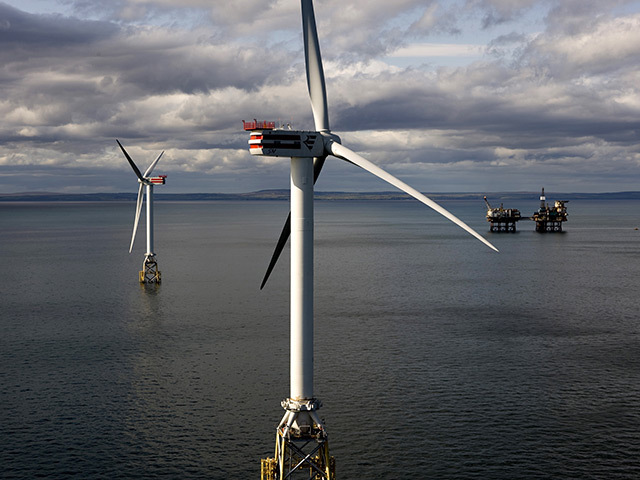
I was in Hamburg recently for the biggest wind power trade show in Europe with 33,000 people attending and 1,500 companies exhibiting.
The impressive aspect of it was that the vast exhibition halls spanned every branch of activity, both onshore and offshore. What distinguished it from our own scenario was the presence of the big manufacturing companies, most of them German.
This was indeed the epicentre of the European renewables industry and it served as a reminder of how little, apart from the issuing of press releases, has been achieved in turning the Scottish renewables potential into manufacturing jobs, in return for the money that has gone into it.
That is not the prospectus that Scotland was offered and it is time for those who have talked endlessly about tens of thousands of jobs and “a new industrial revolution” to ‘fess up and address the reality.
I was there to meet some potential and existing German investors in UK, and particularly Scottish, renewables. All of them are working to the same models – small development teams in Scotland and manufacturing in Germany. Welcome as far as it goes but not at all what we were promised.
The event took place in the week after the Scottish referendum so, looking on the bright side, it was at least possible to give them the message that the potential for renewables development still exists and there will still be a market for the “export” of Scottish renewable energy.
Investment has been on hold for many months due to the uncertainty created by the referendum and also energy market reforms. But the latter would have been irrelevant to Scotland if there had been a vote for independence.
Of all the economic sectors in Scotland, renewables had more to lose than almost any other. Apart from serving the domestic Scottish market, which is pretty much catered for, the whole edifice of Scottish renewables is built on the assumption of exporting to England, and on English consumers paying for the privilege.
It is inconceivable that this arrangement would have survived a vote for independence. Can you imagine any political party in London or Liverpool telling voters, if we had chosen to separate, that they would be required to pay a “Scottish renewables surcharge”? UKIP would have had a field day!
These circumstances make it all the more remarkable that the trade body, Scottish Renewables, remained absolutely silent on the implications of a Yes vote. In other words, they kept their heads down and waited for other people to save their industry which, fortunately, happened.
I can understand individual companies living in fear of Scottish Government planning consents and assorted hand-outs on which they depend. But the point of a trade body like Scottish Renewables is to offer protection from that kind of fear factor by speaking for the industry as a whole.
The morning after the referendum result was known, Scottish Renewables tried to make virtue out of their timidity. “As an organisation,” they declared, “we deliberately took the decision to stay out of the independence debate . . . because we believe the outcome was a matter for the Scottish people alone”.
Well, that’s fine – just so long as they understand that this high-minded stand has also severely damaged their credibility in making demands after the referendum that they were anxious to “stay out of”, as if the alternative outcomes were of no particular relevance to the future of the industry they are supposed to speak for.
Not a bit of it. While I was in Hamburg, the chief executive of Scottish Renewables, Niall Stuart, was speaking at a conference in Inverness where he bemoaned the absence of grid connections to Shetland, Orkney and the Western Isles, a cause in which we are united.
But what Stuart must surely admit to, even retrospectively, is that there would not have been a snowball’s chance in hell of these connections being established if Scotland was now within 18 months of leaving the United Kingdom. What a pity he could not have found the courage to say so, in advance of September 18.
And let us not assume that the miserable performance of Scottish Renewables is a matter only of historic interest. Investment decisions involving billions of pounds will not be made if there is an iota of constitutional uncertainty remaining. Does Mr Stuart agree? If so, he should say so for the avoidance of doubt.
Presumably, the Cromarty Firth cable will now go ahead – though that would not have happened either in the event of a Yes vote.
And it is essential that we do not enter another period of uncertainty about the three islands’ links through a continuing failure to come up with definitive answers on both transmission charges and subsidy level.
From an Ofgem (and maybe SSE) perspective, the referendum was the ideal reason for not producing a decision and kicking the whole thing into touch for the past couple of years. That uncertainty is now behind us, I sincerely hope. So let’s get on with it.
But the Scottish Government – perhaps soon with a new energy minister – also has to answer some hard questions.
Where are the thousands of jobs we were promised?
When, if ever, are marine renewables going to deliver anything other than easy headlines?
Is there any realistic chance of offshore wind happening around Scotland’s coast?
The Scottish electorate are entitled to answers, having been fed so much hype about the “Saudi Arabia of renewables”.
Is it mostly a mirage? Or does Scottish renewables actually equate to hydro (which has been around for decades) plus onshore wind and not much else?
An urgent review of the show so far is required. We are entitled to an outbreak of honesty and realism about Scotland’s energy future.
Recommended for you
